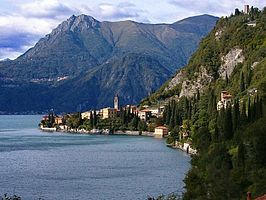Lake Como (Varenna and Domaso)
If the weather in Switzerland is less nice, there is a good chance that the temperature on Lake Como is a lot higher and the sun shines. We went on a day trip to Lake Como. It remained 12°C in…
Continue readingTag
Comomeer | ||||
 | ||||
| Photos | ||||
 | ||||
| Varenna on the east shore of Lake Como | ||||
| ||||
Lake Como (Italian: Lago di Como or Lario) is a lake in Lombardy (northern Italy). With an area of 146 km², it is the third largest of the Italian Alpine lakes and is of glacial origin. It may have been formed as early as 1.8 million years ago. The lake is 198 meters high and has a maximum depth of 425 meters. This makes Lake Como the deepest lake in Italy. In the lake is a small island, the Isola Comacina. The highest mountain on the lake is Monte Legnone (2609 m) which rises south of Colico.
The main water supply is the Adda River, which enters the lake in the north at Colico and leaves in the southeast at Lecco. The largest city on the lake is also its namesake: Como. This silk town is located at the southwest tip of the lake, which is shaped like an inverted Y.
In the northernmost part of the lake is the Pian di Spagna plain, which separates it from the Lago di Mezzola lake. In Roman times, when Lake Larius was called, it was still part of Lake Como. Due to the many floods of the river Adda, the delta that now separates the two has been created in a relatively short time. Both lakes are still connected by the river Mera, which rises near the Splügen Pass.
At the point where the lake branches, the Castello di Vezio overlooks the lake.
Source: Wikipedia
If the weather in Switzerland is less nice, there is a good chance that the temperature on Lake Como is a lot higher and the sun shines. We went on a day trip to Lake Como. It remained 12°C in…
Continue reading